|
|
John Feldmeier's Astronomical Research
Here's a brief summary of the
different astronomy fields that I work on. For more details, you can
see my list of publications
What's intracluster light anyway?
What's a planetary nebula?
|
|

|
Searching for intracluster light through deep imaging
Using both the KPNO 2.1 meter telescope and the Case Burrell Schmidt telescope, we are
conducting a deep imaging survey of clusters and groups of galaxies, to detect
and quantify the structure of the diffuse intracluster starlight as a function
of cluster and group properties.
Collaborators: Chris Mihos, Heather Morrison, Paul Harding
|
|

|
Searching for intracluster light using planetary nebulae
Planetary nebulae are excellent tracers of the intracluster light in
nearby galaxy clusters because they allow for both
spatial and kinematical studies. We have conducted multiple narrow-band
imaging surveys of nearby galaxy clusters to find intracluster planetaries,
and have obtained follow-up spectroscopy for some of them to obtain radial
velocities.
Primary Collaborators: Robin Ciardullo, George Jacoby, Patrick Durrell,
Kelly Holley-Bockelmann, Chris Mihos
Secondary Collaborators: Magda Arnaboldi, Ken Freeman, Ortwin Gerhard, Holland Ford, Aaron Romanowsky
|
|
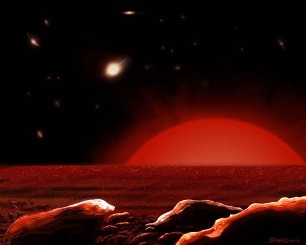
|
Searching for intracluster light using red giant stars
Another way to learn about intracluster stars is through imaging intracluster red giant stars with the Hubble
Space Telescope. This allows us to learn detailed properties of the stellar population of the intracluster stars.
Primary Collaborators: Robin Ciardullo, George Jacoby, Patrick Durrell, Ben Williams, Steinn Sigurdsson
Secondary Collaborators: Magda Arnaboldi, Harry Ferguson, Ken Freeman, Ortwin Gerhard, Ted von Hippel, Nial Tanvir,
|
|
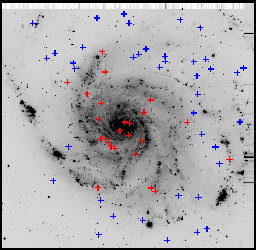
|
Finding the distances to galaxies using planetary nebulae
Using the [O III] 5007 emission line, and the empirical planetary nebula luminosity function (PNLF) distance indicator, the distances to nearby galaxies can be found to high precision, comparable to that of Cepheids. Our recent focus has been only applying the PNLF method to spiral galaxies, and to better calibrate the absolute magnitudes of supernovae Type Ia
Collaborators: Robin Ciardullo, George Jacoby, Mark Phillips
|
|

|
Understanding stellar populations in galaxies using planetary nebulae
Since planetary nebulae are one of the normal end phases of stellar evolution, by measuring the number of
planetary nebulae in a distant galaxy, we can probe the mechanices of stellar evolution. We have been
surveying planetary nebulae in both spiral and elliptical galaxies and comparing them to the overall
stellar distribution.
Collaborators: Robin Ciardullo, George Jacoby, Kim Herrmann
|
|

|
Emission-line studies of nearby galaxies
Studying the ionized gas of nearby galaxies can be useful for many topics in astrophysics. Currently, I'm involved in groups studying the giant elliptical galaxy M86 (seen here in Hydrogen-alpha emission), and also in a search for Gamma-Ray burst remnants.
Collaborators: George Jacoby, Jeffrey Kenney, Tomer Tal, Hugh Crowl,
James Rhoads, Rosalba Perna, Jochen Grenier, S.G. Bhargavi
|
|
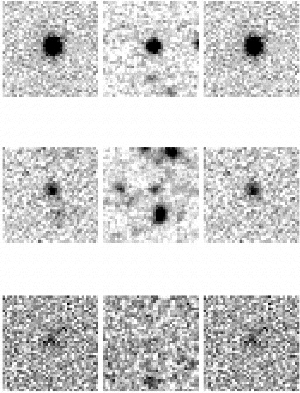
|
Studying high-redshift emission-line galaxies
Searches for extragalactic planetary nebulae turn out to be also
good ways to find Lyman-alpha galaxies, particularly those around a redshift
of z = 3.1. We have compiled a large sample of these galaxies, and are studying their properties. On the left are some
examples of Lyman-alpha galaxy candidates. Notice that the object is present in the left-most frame, but almost
disappears in the middle frame. The right frame is the two images subtracted by each other, which shows the
candidate clearly.
Collaborators: Robin Ciardullo, Caryl Gronwall, Eric Gawiser
and the MUSYC collaboration
|
|

|
High-Precision Stellar Variability Observations
Using careful observing, reduction, and analysis techniques,
we can perform relative photometry as accurate as a few milli-magnitudes using
1-meter class telescopes, such as the Burrell Schmidt. We intend to use these capabilities to carry out some long-term studies of variable stars, and to possibly search for extra-solar planetary transits. On the left is a light curve of the RR Lyrae star CL Boo.
Collaborators: Steve Howell, Mark Everett, Chris Mihos, Paul Harding, Bill Sherry, Kaspar von Braun
|
|

|
Applying Astronomy Education Research to the Classroom
We are using the new astronomy education tools developed by the Center for Astronomy
Education (CAE) at the University of Arizona's Steward Observatory and the Cognition in Astronomy,
Physics and Earth sciences Research (CAPER) Team at the University of Wyoming. Our goal is
to refine and fine-tune these tools to aid student learning, and to better apply them to
our classrooms.
Collaborators: Ed Prather, Gina Brissenden, Timothy Slater, Patrick Durrell
|
|
|
|
|
|
|
Intracluster light (ICL) is optical light that is emitted between the galaxies
in a galaxy cluster or group. This light, sometimes called the diffuse light, mostly
comes from intracluster stars,
which are stars between the galaxies. It is generally
thought that most of the stars were actually formed within galaxies, but were then were
later ejected from them, usually due to interactions between galaxies, or with the gravitational
force of an entire cluster themself.
Below here is an image of the center region of the Virgo Cluster of galaxies. You can see
many images of this region in the sky in astronomy books of all kinds:
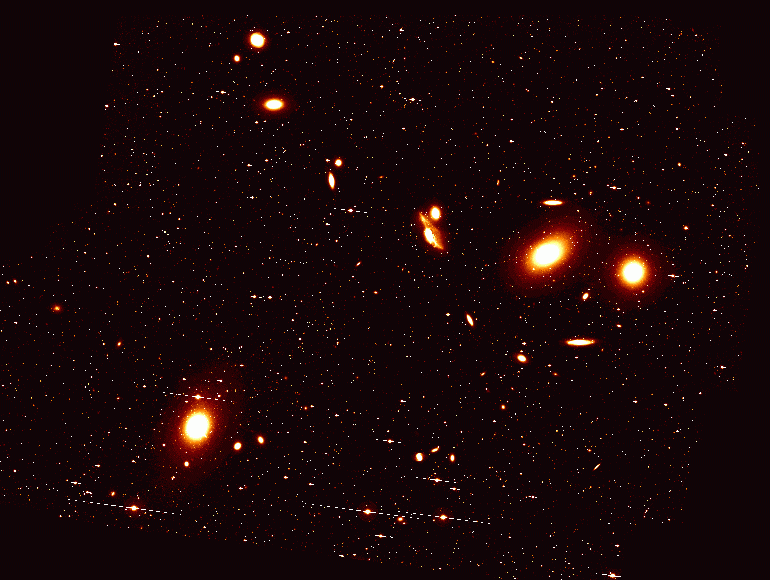
Now, look at the image below. Notice that the space betwen the galaxies is
filled with light in complicated structures:
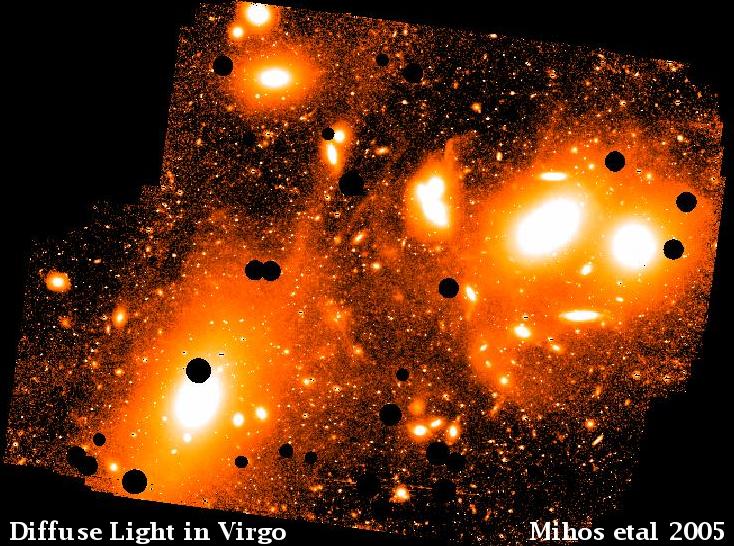
(see here for a press release about
these images)
Some high quality computer animations that show the creation of intracluster light can be found
with my collaborators, Chris Mihos and John Dubinski. The animations can be found
here and
here.
So, if intracluster light is so interesting, why is it not well known? Well, the
original idea of intracluster light was first proposed by the scientist
Fritz Zwicky in 1951. So the concept has been around for over fifty years, and
three generations of scientists have looked for the intracluster light.
Actually observing the intracluster light is very difficult
because the light is spread out over a large area.
A simple example will explain this better. Suppose we have a small container
of food coloring:
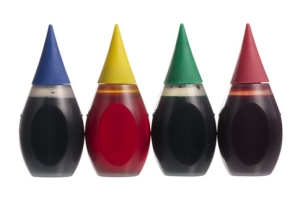
We can see the colors clearly with our eyes. Now, drop some food coloring into a swimming pool:

For maybe a minute or two, we can still see the food coloring dye, but it will quickly spread out
through the pool. The atoms that make up the food coloring however, are still there, just
difficult to see. Likewise, there can be a lot of light between the galaxies, but if it is spread
out over a large area it becomes hard to observe. We observe the intracluster light two
different ways. First, we directly image the intracluster light, using special techniques,
and specialized telescopes to pull out the faint emission. Second, we search for bright
individual intracluster stars in nearby clusters, and use those observations to
understand the global properties of the intracluster light.
A nice article by the famed science writer Dennis Overbye about intracluster light
in the Virgo cluster can be found at the New York Times
website here.
A planetary nebulae is an ending phase of a star's life that most stars between 0.8 times
the mass of the Sun and 8 times the mass of the sun go through. A planetary nebulae
consists of 1) the remaining hot stellar core of the star (that will eventually become
a white dwarf star), and 2) an expanding shell of gas that is being ionized by the hot
core. Planetary nebulae exist for very short lifetimes, as far as stars go, only
25,000 years.
There are many beautiful pictures of planetary nebulae. Here is a famous
example, the Ring Nebula:
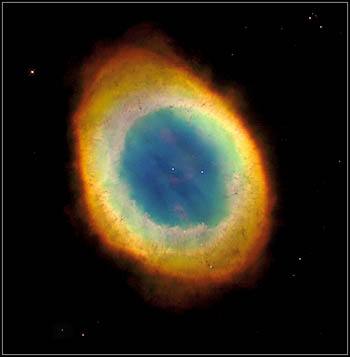
There is a very complete Wikipedia article on planetary nebulae
here
|













